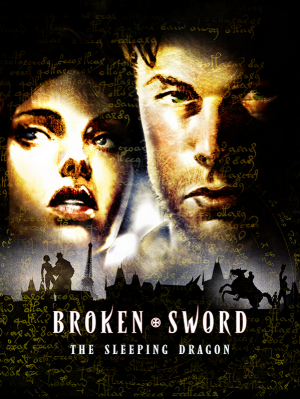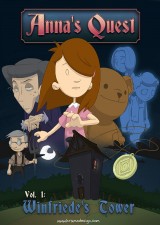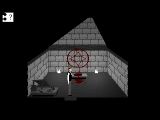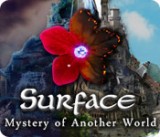Review for Broken Sword: The Sleeping Dragon
The adventure genre has been begging for years for a game to come along that would bowl over mainstream critics and the general populace; a game that would dazzle the senses, challenge the mind, tell an emotionally compelling and perfectly-paced story, and reestablish the adventure genre as commercially viable, the way Baldur’s Gate did for the nearly-deceased PC RPG genre five years ago. When Revolution Software’s Charles Cecil, already with two to four (depending on who you ask) brilliant adventure games to his credit, merrily informed us that point & click adventures were dead and he was about to single-handedly redefine the future of the genre we love, the reaction was perfectly split: half loathing, including a misguided few who thought themselves important enough to lead a boycott against the treasonous designer, and the polar-opposite revolutionaries who had been praying for someone to turn adventure gaming on its ear and then back again, and were certain that Charles Cecil was the man for the job.
For a community often overeager to characterize itself as down-trodden and ignored by the mainstream, the idea that a game like this could be a big enough deal that even Joe Schmoe FPS-guy would give thought to purchasing it instantly shot the hype level to fever-pitch, and as early as six months before the game’s release there was no way to not have an opinion on Broken Sword: The Sleeping Dragon; you either awaited its Messianic coming with arms wide open, or you crouched scowling with flaming arrows in hand ready to hate its every innovative moment. If that sounds like over-the-top writing to you, you obviously weren’t participating in forum discussions about the game a couple months ago.
So, lo and behold, this harbinger of revolution has now arrived in playable form, and what do we find? Broken Sword 3 is a good game, a very good game, a great game in fact. It’s even an important game, a special game, a revolutionary game. It dazzles the senses at times, challenges the mind at others, establishes its characters as well as any game in years, and even tells a heck of a story that remains compelling and interesting all the way to the end. But it also comes with its share of flaws, and while setting the stage for a promising future, reminds us that there’s still a lot of room to grow.
I’m not even going to waste my virtual breath discussing whether the game is an adventure; if you don’t know that by now, you’re just not paying attention. There’s jumping and sneaking and climbing galore, but it’s all done in such a perfect adventure style that there is certainly no danger of the feared Tomb Raider comparisons. Direct character control, with excellent GamePad support (a must for any experienced console gamer) and full key-remapping ability, combine to provide a sense of interaction far superior to traditional point & click.
The characters of George Stobbart and Nicole Collard, cynical American lawyer turned intrepid explorer and lovably snobby French reporter, are already among the favorites in adventure gaming history, as a result of the generally excellent dialogue and intelligent character progression through the first two Broken Sword games. In this game, they are immortalized as a pair to rival Grace and Gabriel; the dialogue is the most consistently excellent of the series (which is quite a statement) and the interplay between the two characters is especially great, with lots of amusing romantic tension and the best character traits of the two being utilized to great effect, particularly George’s insecurity around other men.
The story itself is of grand proportion, not at all a step down from the globe-trotting epics of the two previous games. This time we’re hitting the Congo, Paris, Glastonbury, Prague, and even Montfaucon Square, the site of the café bombing where the original Broken Sword opened up. It was one of the greatest rushes of nostalgia to run around that area, rendered in gorgeous 3D, and to once again talk to the same construction guy from whom the sewer tool was taken lo those many years ago. What was striking about that scene, and many scenes in the game, was how incredibly faithful to the spirit and tone of the original game this game is. In the conversations, in the character animation, in the item descriptions, in the characters’ stubborn refusal to do things they’re not supposed to…we’ve seen many sequels that undergo massive technical makeovers and end up feeling like a cold copy of what made the series so great in the first place (King’s Quest VII and Simon 3D come to mind right away); here is a perfect example of how a game can evolve technically and still feel so perfectly nostalgic. (ed. note: I have since been informed by Revolution that Montfaucon Square is not actually where the café bombing took place...it only looks 100% like it in every way and has the same maintenance guy up the street...)
And a technical masterpiece, Broken Sword: The Sleeping Dragon is. The gorgeous cinematic introduction provides a breathtaking landscape for the story yet to unfold, and the frequent cutscenes certainly raise the bar for any seen in adventures to this date. Of special importance is the increased attention to detail in the character’s faces; there are important emotional moments late in the game when George’s facial expressions are extraordinarily life-like, able to tell the story without words. It’s quite a feat that adventures can now convey pain and regret without the use of dialogue.
The theme of “cinematic quality” continues into another aspect: the soundtrack is quite wonderful, one of very very few that has made me notice it for the right reason: that it provides enhanced intensity at the right moments and subtle emotional undercurrent at others. As a musician myself, I’m of the firm belief that we don’t realize the power music can have on our emotions, and for too long I’ve just been happy enough to not have to bring up how bad a game’s soundtrack is. I’m pleased to do otherwise here.
The camera work is alternatively fascinating and frustrating. There are brilliant moments, such as when you are edging George across a building ledge and the camera slowly pans and zooms out in order to show us just how perilous his situation is, and then gently zooms back in as George reaches the other end without ever hampering your ability to maneuver across. There are also an excessive amount of hard camera cuts that, for a camera-relative control system, prove disorienting far too often, and in more than one situation it is possible to get shot by a guard who you have absolutely no way of seeing, because you can’t quite maneuver your character in the right spot to trigger the hard cut that will show you the guard. There’s also plenty of instances where you’re running northwest, and just as you try to turn left—hard cut!, and suddenly your character is running southeast and you’ve completely turned the wrong direction. I’m in no way advocating character-relative controls, which I find far more frustrating, but here is definitely an area where this whole “point & click is dead, 3D is the present and the future” thing still is working out the growing pains.
That is a minor weakness, though, in comparison to the game’s extraordinarily flawed puzzle design. I lost interest completely on more than one occasion due to the game’s absolutely baffling insistence on crate puzzles. Move crate 1 in position so that crate 2 can be pushed across it to crate 3, then go back and move crate 1 around in order to align it with crate 4 and allow crate 5 to…blah blah blah times ten. Now, I’m not even saying crate puzzles are a bad idea…and the first two or three in the game were pretty good. Apathy sank in during the next fifteen. Then, the final 634 crate puzzles were just plain maddening. Let me tell you something, if I’m standing in an alley and there’s a crazy Grand Master about to destroy the world on the other side, you better believe it’s not going to take half an hour of pushing eight crates all over the place for me to get over the wall. I mean, are these crates filled with bowling balls? Would it be too much to ask for George to lift one? Why on God’s gravity-controlled earth can I not just push a crate off of another crate, down to the ground? Why do I have to be standing on the same level as a crate in order to move it? This wonderful new emphasis on reality that 3D gaming brings us just falls all to pieces here. Multiple, multiple times, the game comes to a screeching halt as Crate-O-Rama replaces any momentum that the brilliant story is able to build up. It’s almost funny, after the first couple hours, to realize that if there is a ledge or a window or a gate or something that looks like it might be challenging to reach, you know it will involve moving crates around like you’re freaking Kickle Cubicle for an hour before you can resume saving the world.
I have yet to read a review that isn’t far too nice on these puzzles, but they aren’t the entire problem with the puzzle design. The traditional inventory-based puzzles that the first two Broken Sword games elevated to an artform have almost completely been eschewed in favor of more “puzzly” puzzles. There’s one that takes a good half-hour that involves you as George slowly crossing an eternal sequence of tiles, occasionally ordering Nico to move in order to make different tiles “safe.” Your reward for getting through this torture chamber, likely forgetting why you’re even here in the process? A crate puzzle. I wish I was kidding. I would have given anything to use the fishnet on the vine and then throw it over the stone pillar (and God bless you for getting the reference), but after the first two hours the inventory almost feels like an afterthought.
Thankfully, though, you can always count on the next cutscene and plot development to wipe your mind clean of the turmoil you’ve just endured, and when it was all said and done and the fantastic (though slightly short, just like the previous two games in the series) ending sequence had played out, that was what I remembered: the sheer cinematic excellence.
I feel it necessary now to mention three other games. First, it will undoubtedly be brought up that I gave Runaway a superior score of 4.5/5 earlier this year, and I’m going to take it like a man and say that I was wrong, and in no way do I ever think that Runaway is a better game than Broken Sword 3, although I do think it is quite unfairly criticized. Second, after years of being characterized as “the guy who hates Grim Fandango” (which is ludicrously untrue), I must say that playing BS3 has given me new appreciation for GF, which did 3D at a time and in a way that no one could relate to. The fact that we’re still having problems with 3D games being disorienting and occasionally confusing five years later, makes it clear how remarkable it was that Grim Fandango had as few problems as it did. Third, while the sequels have proven to be quite worthy continuations of the epic tale, there is absolutely no question the original Broken Sword remains the king, in my opinion one of the five greatest adventures ever due to its brilliant pacing, excellent puzzle design, and perfect length. While an excellent adventure, probably the best of this year, this sequel is not even in the same league as the original, and very likely not a candidate for a spot on the infamous Top 20.
An amazing, brilliant story, at times told with such directorial excellence as to bring out emotions normally reserved for Final Fantasy. Gorgeous, eye-popping cutscenes. Infuriatingly stupid puzzle design at nearly every step of the way. Broken Sword: The Sleeping Dragon is a game of breathtaking highs and ridiculous lows, and thankfully the highs definitely outnumber the lows (moreso if you’re better at crate puzzles than me, which apparently shouldn’t be too difficult). The bold attempts to innovate and push the adventure to new places are generally successful and quite welcome. The production excellence and storytelling skill is unsurpassed by any game, adventure or otherwise, that you can find on the market today; never before has the title “Director” actually seemed to fit in a adventure game better than “Producer,” and Charles Cecil should wear the title proudly. If I ever have the pleasure of meeting him, I will shake his hand, express my fondness for his games, congratulate him on the stand he’s taken to lead adventure gaming out of its rut, then put him in a locked room with eight crates and see if it takes him half an hour to get out.
WHERE CAN I DOWNLOAD Broken Sword: The Sleeping Dragon
Broken Sword: The Sleeping Dragon is available at:
- GOG -75%
- HumbleBundle
- Amazon




























